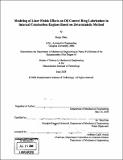Modeling of liner finish effects on oil control ring lubrication in internal combustion engines based on deterministic method
Author(s)
Chen, Haijie
DownloadFull printable version (24.53Mb)
Other Contributors
Massachusetts Institute of Technology. Dept. of Mechanical Engineering.
Advisor
Tian Tian.
Terms of use
Metadata
Show full item recordAbstract
Twin-land oil control ring is widely used in the automotive diesel engines, and is gaining more and more applications in the modern designs of gasoline engines. Its interaction with the cylinder liner surface accounts for around 10% of the total frictional losses within an internal combustion engine, and is the most important factor that affects the lubricant oil consumption. A twin-land oil control ring model is developed based on the deterministic hydrodynamic method by Li et al. [31] and the Greenwood Tripp asperity contact model [39]. Unlike the traditional methods of piston ring pack modeling determined by the ring face macro profile which hardly exists on the twin-land oil control ring, the model considers the liner finish micro geometry, and uses a correlation method to predict the behavior of the ring liner interaction in both frictions losses and oil control. The model is used to study the effect of some key design parameters of the twin-land oil control ring, including the unit load pressure, the ring tension and the ring axial land width. The results show a large potential of the model in the optimization of the twin-land oil control ring design. Although many non-conventional cylinder liner finishes are now being developed to reduce friction and oil consumption, the effects of surface finish on ring-pack performance is not well understood. To solver this mystery, the twin-land oil control ring model and Li's deterministic hydrodynamic model are used to study the effect of the liner finish micro geometry. Several key parameters of liner finish texture are examined, and the analytical results show important effects of some of these key parameters on the twin-land oil control ring friction losses as well as the lubricant oil control. (cont.) These key parameters include the surface wavelength of the plateau part, the frequency of deep valleys and the honing cross-hatch angle. This thesis work has opened a window on the deterministic study of the functionality of cylinder liner surface texture.
Description
Thesis (S.M.)--Massachusetts Institute of Technology, Dept. of Mechanical Engineering, 2008. Includes bibliographical references (p. 117-119).
Date issued
2008Department
Massachusetts Institute of Technology. Department of Mechanical EngineeringPublisher
Massachusetts Institute of Technology
Keywords
Mechanical Engineering.